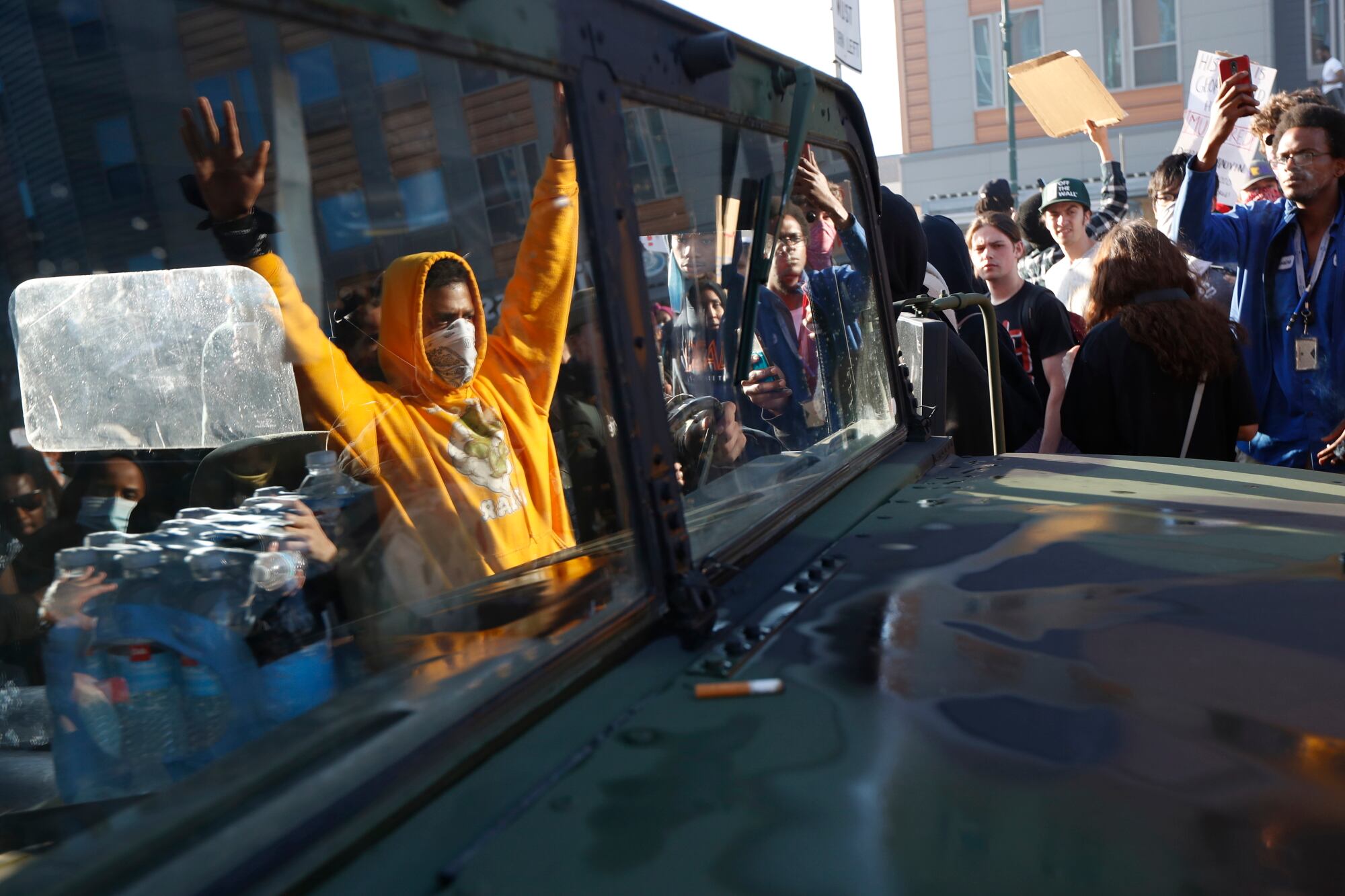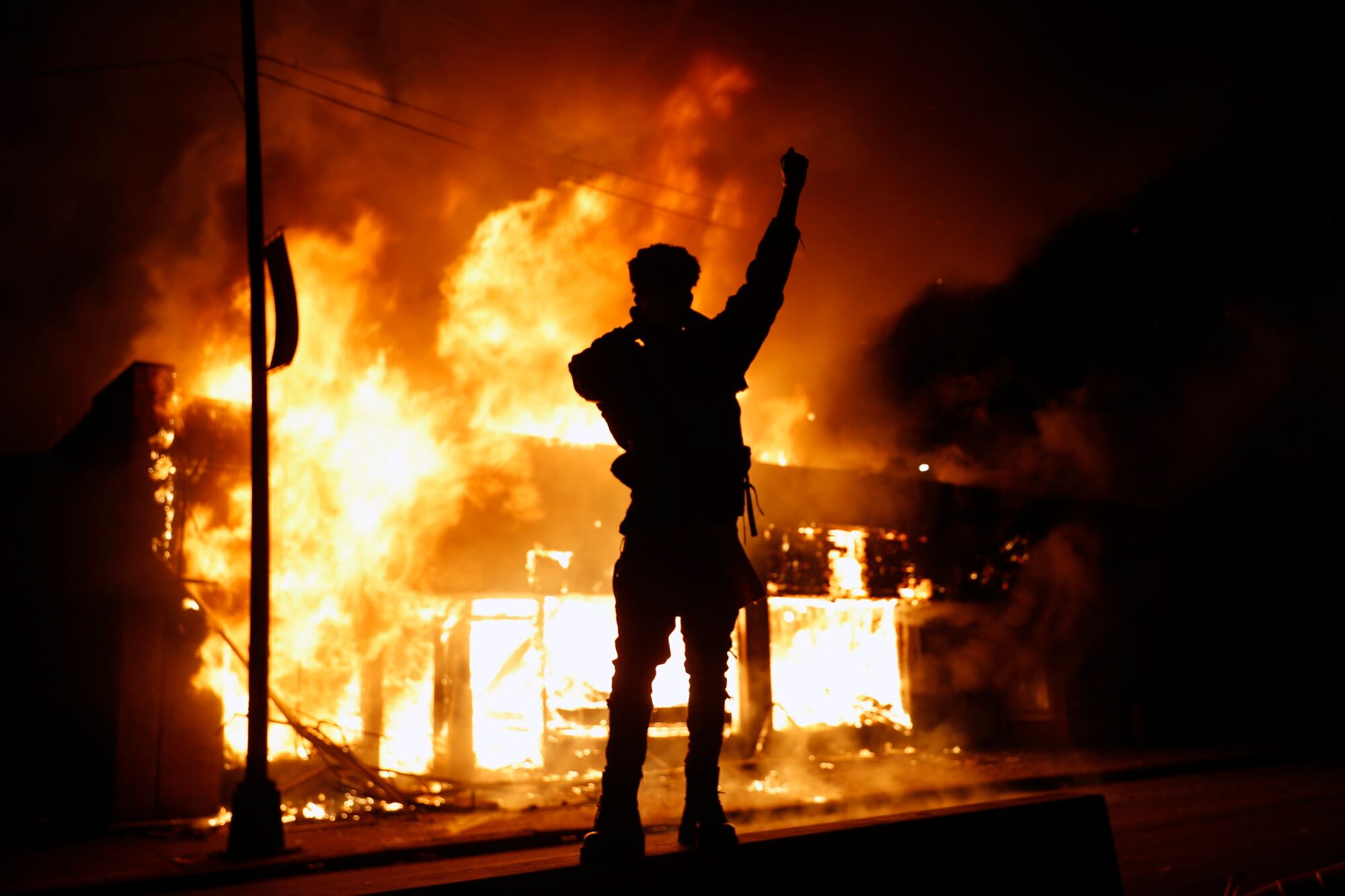After days and nights of increasingly violent protest over what prosecutors say was the murder of a handcuffed black man by Minneapolis police, Minnesota Gov. Tim Walz has ordered the largest National Guard mobilization in state history.
He has also asked the Pentagon for help tracking what he said are mostly out of state agitators who are driving much of the resulting unrest.
Georgia, Kentucky and the District of Colombia have also activated National Guard troops in reponse to civil unrest, a National Guard official told Military Times.
“More than 1,000 additional Citizen-Soldiers and Airmen are activating today,” the Minnesota National Guard tweeted this morning. “This is in addition to the 700 that were on duty as of late last night. This represents the largest domestic deployment in the Minnesota’s National Guard’s 164-year history.
“We are ‘all-in’ to restore order and maintain and keep the peace in Minnesota.”
The MNNG has more than 13,000 soldiers and airmen, according to a statement from the MNNG. A full activation authorizes the guard to activate all those that are medically fit, and not deployed to support the mission to quell civil unrest. Initial estimates are that could include between 7,000 to 10,000 troops, including nearly 2,500 by tonight to support the Saturday evening missions. The remainder will muster and become available during coming days.
During a Saturday morning press conference, Walz told reporters he had spoken “extensively” with both Defense Secretary Mark Esper and Army Gen. Mark Milley, chairman of the Joint Chiefs of Staff, to provide them an update on the situation and “suggest courses of action going forward.”
Walz said it was the second conversation in 24 hours with Esper and Milley, and that he was asking DoD for additional help that includes signals intelligence to help figure out how the protesters are organizing. Walz estimated that 80 percent of those involved in the unrest are coming into Minnesota from out of state.
“We are looking at what other resources they have,” he said of DoD. “Is there signals intelligence we can get from them, what other things that they could provide us?”
The Minnesota governor also said he was “talking about the mechanisms we use with the National Guard. It’s really important to think about again the uniqueness of our nation of protecting civil liberties to make sure there is civilian control of the military, especially inside the United States is carried out by civilians, by citizens-soldiers, by the National Guard.”
It’s a discussion involving “the Insurrection Act,” he said, referring to a law stating that “whenever there is an insurrection in any State against its government, the President may, upon the request of its legislature or of its governor if the legislature cannot be convened, call into Federal service such of the militia of the other States, in the number requested by that State, and use such of the armed forces, as he considers necessary to suppress the insurrection."
Walz, saying he was the lead author of a 2007 revision of that law, added that he understands “very clearly the militarization of the civilian population is a deep concern. That is why we are accessing, and they are helping us access, all these assets through the National Guard and our surrounding states.”

Esper and Milley were “also able to provide their intelligence support of what they’re seeing, what they are signal intercepting. And they have, obviously from NSA and others, massive support to be able to see who these operators are.”
Pentagon spokesman Jonathan Rath Hoffman said both men spoke with Walz and "expressed the department’s readiness to provide support to local and state authorities as requested. "
Walz “is fully activating the Minnesota National Guard and is working with neighboring states for more potential support,” said Hoffman in a statement. “At this time there is no request by the Governor of Minnesota for Title 10 forces to support the Minnesota National Guard or state law enforcement.”
However, as "a prudent planning measure, the department has directed U.S. Northern Command to increase the alert status of several units should they be requested by the Governor to support Minnesota authorities. These are units that normally maintain a 48-hour recall to support state civil authorities.
In addition to Minnesota, Georgia, Kentucky, and the District of Columbia have National Guardsmen on duty in response to the protests in their states, April Cunningham, a National Guard spokeswoman, told Military Times.
In D.C., 100 National Guard troops have already mobilized, with another 100 expected, said Cunningham, who did not have numbers for Georgia or Kentucky.
“Several other states have alerted National Guard elements, and are conducting staff planning for potential employment should the governor request National Guard support,” she said.
Civil unrest gets out of control
Protests first erupted Tuesday, a day after Floyd’s death in a confrontation with police captured on widely seen citizen video. On the video, Floyd can be seen pleading as Officer Derek Chauvin presses his knee against him. As minutes pass, Floyd slowly stops talking and moving. The 3rd Precinct covers the portion of south Minneapolis where Floyd was arrested. Chauvin, one of four officers fired from the force after Floyd’s death, was arrested Friday and charged with murder.
RELATED

Walz told reporters that law enforcement and Guard troops were outnumbered late Friday and early Saturday, and had to prioritize what to protect, according to Minnesota Public Radio.
“When the business that you fought your life for to try and get burns down, that seems like a pretty damn critical asset to you,” he said. “[But] we’re protecting the Federal Reserve, we’re protecting infrastructure downtown, we’re protecting power stations and things like that.”
Walz said groups who are only interested in destruction have taken over the protests in the wake of Floyd's death.
“Why are we talking about anarchists who are burning down damn buildings, that were businesses built up by our indigenous and black communities, instead of talking about — we had a horrific situation where a police officer murdered and was charged for the death of a black man?” he said.
Walz says the state has intelligence that white supremacists and drug cartels might also be trying to take advantage of the unrest.
Military police at the ready?
Late Friday, the Associated Press reported that the Pentagon took the rare step of ordering the Army to put several active-duty U.S. military police units on the ready to deploy to Minneapolis.
Soldiers from Fort Bragg in North Carolina and Fort Drum in New York have been ordered to be ready to deploy within four hours if called, three people with direct knowledge of the orders to the AP.
According to the report:
Soldiers in Fort Carson, in Colorado, and Fort Riley in Kansas have been told to be ready within 24 hours. The people did not want their names used because they were not authorized to discuss the preparations.
The get-ready orders were sent verbally on Friday, after President Donald Trump asked Esper for military options to help quell the unrest in Minneapolis after protests descended into looting and arson in some parts of the city.
Trump made the request on a phone call from the Oval Office on Thursday night that included Esper, National Security Advisor Robert O’ Brien and several others. The president asked Esper for rapid deployment options if the Minneapolis protests continued to spiral out of control, according to one of the people, a senior Pentagon official who was on the call.
”When the White House asks for options, someone opens the drawer and pulls them out, so to speak.” the official said.
The person said the military units would be deployed under the Insurrection Act of 1807, which was last used in 1992 during the riots in Los Angeles that followed the Rodney King trial.
“If this is where the president is headed response-wise, it would represent a significant escalation and a determination that the various state and local authorities are not up to the task of responding to the growing unrest," said Brad Moss, a Washington, D.C.-based attorney, who specializes in national security.
Members of the police units were on a 30-minute recall alert early Saturday, meaning they would have to return to their bases inside that time limit in preparation for deployment to Minneapolis inside of four hours. Units at Fort Drum are slated to head to Minneapolis first, according to the three people, including two Defense Department officials. Roughly 800 U.S. soldiers would deploy to the city if called.
Alyssa Farah, the White House director of strategic communications, told AP the deployment of active-duty military police is untrue.
“False: off the record - title 10 not under discussion,” said Farah in an email response. No off-record agreement was negotiated with The Associated Press.
Howard Altman is an award-winning editor and reporter who was previously the military reporter for the Tampa Bay Times and before that the Tampa Tribune, where he covered USCENTCOM, USSOCOM and SOF writ large among many other topics.
